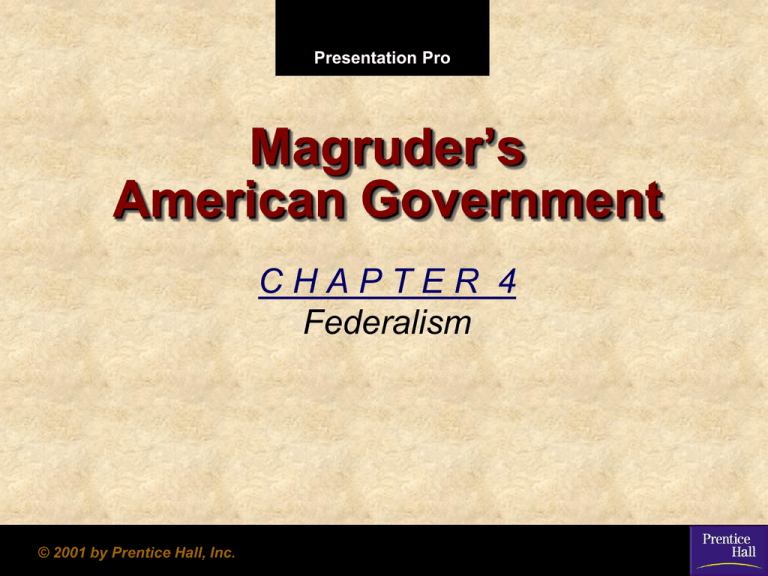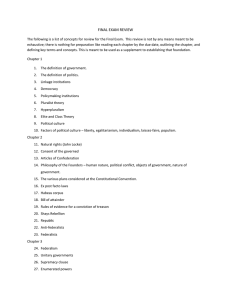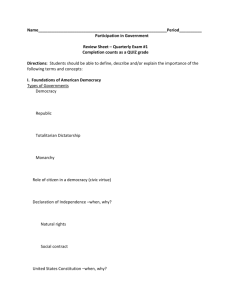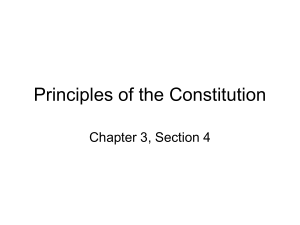Chapter 4, Section 1 - School District of Bloomer
advertisement

Presentation Pro Magruder’s American Government CHAPTER 4 Federalism © 2001 by Prentice Hall, Inc. CHAPTER 4 Federalism SECTION 1 Federalism: The Division of Power SECTION 2 The National Government and the 50 States SECTION 3 Interstate Relations Go To Section: 1 2 3 Chapter 4 SECTION 1 Federalism: The Division of Power • • • • • What is federalism, and why was it chosen by the Framers? What powers are delegated to and denied to the National Government, and what powers are reserved for and denied to the States? What exclusive powers does the National Government have, and what concurrent powers does it share with the States? What place do local governments have in the federal system? How does the Constitution function as “the supreme Law of the Land?” Go To Section: 1 2 3 Chapter 4, Section 1 L.O.4.1-1: What is federalism, and why was it chosen by the Framers? Why Federalism? The Framers were dedicated to the concept of limited government. They were convinced (1) that governmental power poses a threat to individual liberty, Texas NPR (2) that therefore the exercise of governmental power must be restrained, and (3) that to divide governmental power, as federalism does, is to curb it and so prevent its abuse. Go To Section: 1 2 3 Chapter 4, Section 1 L.O.4.1-1: What is federalism, and why was it chosen by the Framers? Federalism Defined Federalism is a system of government in which a written constitution divides the powers of government on a territorial basis between a central, or national, government and several regional governments, usually called states or provinces. The Constitution provides for a division of powers, assigning certain powers to the National Government and certain powers to the States. Go To Section: 1 2 3 Chapter 4, Section 1 L.O.4.1-2: Identify powers delegated to and denied to the Federal government and powers reserved and denied to the states Powers of the National Government • • • The National Government is a government of delegated powers, meaning that it only has those powers delegated (granted) to it in the Constitution. There are three types of delegated powers: The expressed powers are those found directly within the Constitution. Article 1, Section 8 The implied powers are not expressly stated in the Constitution, but are reasonably suggested, or implied by, the expressed powers. Article 1, Section 8 Clause 18 The inherent powers belong to the National Government because it is the government of a sovereign state within the world community. There are few inherent powers, with an example being the National Government’s ability to regulate immigration. Preamble? Go To Section: 1 2 3 Chapter 4, Section 1 L.O.4.1-2: Identify powers delegated to and denied to the Federal government and powers reserved and denied to the states Quick Quiz Explain What is it Where is it found in the Constitution? • Expressed Powers • • • Go To Section: Implied Powers Inherent Powers Reserved Powers?? (10th Amendment) 1 2 3 L.O.4.1-2: Identify powers delegated to and denied to the Federal government and powers reserved and denied to the states Powers Denied to the National Government Powers are denied to the National Government in three distinct ways: • Some powers are expressly denied to the National Government in the Constitution…Article I, Section 9 (765) and the Bill of Rights (771) –List those Powers DENIED • Finally, some powers are denied • Also, some powers are denied to the National Government because the Constitution is silent on the issue…. • Provide two Examples Go To Section: 1 2 3 to the National Government because the federal system does not intend the National Government to carry out those functions. Two examples (10th Amendment again) Chapter 4, Section 1 The States Powers Reserved to the States 10th Amendment (773) • • The 10th Amendment declares that the States are governments of reserved powers. The reserved powers are those powers that the Constitution does not grant to the National Government and does not, at the same time, deny to the States. Go To Section: 1 2 3 Powers Denied to the States Article 1, Section 10 p.765 • • Just as the Constitution denies many powers the National Government, it also denies many powers to the States. Powers denied to the States are denied in much the same way that powers are denied to the National Government; both expressly and inherently. Chapter 4, Section 1 L.O.4.1-3: Understand that the national government holds exclusive, as well as concurrent powers with the states The Exclusive and Concurrent Powers Exclusive Powers • Powers that can be exercised by the National Government alone are known as the exclusive powers. How would you find these Concurrent Powers • (765)? • Examples of the exclusive powers are the National Government’s power to coin money, to make treaties with foreign states, and to lay duties (taxes) on imports. Go To Section: 1 2 3 • The concurrent powers Art. 1, Sec.10. are those powers that both the National Government and the States possess and exercise. Some of the concurrent powers include the power to levy and collect taxes, to define crimes and set punishments for them, and to claim private property for public use. Chapter 4, Section 1 L.O.4.1-3: Understand that the national government holds exclusive, as well as concurrent powers with the states The Division of Powers The federal system determines the way that powers are divided and shared between the National and State governments. Go To Section: 1 2 3 Chapter 4, Section 1 L.O.4.1-3: Understand that the national government holds exclusive, as well as concurrent powers with the states The Federal System and Local Governments • There are more than 87,000 units of local government in the United States today. • Each of these local units is located within one of the 50 States. Each State has created these units through its constitution and laws. • Local governments, since they are created by States, are exercising State law through their own means… Do local governments have any power of their own? Texas NPR Go To Section: 1 2 3 Chapter 4, Section 1 Review Fast Federalism Review Faster Federalism Review For Tuesday: Read pp. 88-95 Respond: How do… - Art. I, Sec. 8 - The 10th Amendment - Art I. Sec. 9 and the Bill of Rights - Art. I, Sec. 10 …define Federalism Go To Section: 1 2 3 Chapter 4, Section 1 L.O.4.1-4: Assess the significance of the Necessary and Proper clause and Article VI to the growth of federal power The Supreme Law of The Land Supreme Court Case Studies Always provide the following: 1. 2. 3. 4. Backgound of the case The question before the Court The holding Rationale (Found in the majority opinion • Gibbons v. Ogden • McCulloch v. Maryland Go To Section: 1 2 3 4.1 Quiz Review L.O.4.1-1: What is federalism, and why was it chosen by the Framers? L.O.4.1-2: Identify powers delegated to and denied to the Federal government and powers reserved and denied to the states L.O.4.1-3: Understand that the national government holds exclusive, as well as concurrent powers with the states L.O.4.1-4: Assess the significance of the Necessary and Proper clause and Article VI to the growth of federal power 4.1 GR Division of Power •Exclusive (National or State) •Concurrent (both) Go To Section: 1 2 3 SECTION 2 The National Government and the 50 States • What obligations does the Constitution place on the nation for the welfare of the States? • How are new States admitted to the Union? • What are the many and growing areas of cooperative federalism? Go To Section: 1 2 3 Chapter 4, Section 2 L.O.4.2-1: Summarize the obligations that the Constitution places on the nation for the benefit of the states What are The Nation’s Obligations to the States?Art. IV,Sec.3,4 (770) Republican Form of Government • The Constitution requires the National Government to “guarantee to every State in this Union a Republican Form of Government.” Invasion and Internal Disorder • The National Government is also required to provide defense of the States from foreign invasion, and aid in protecting against “domestic Violence” in the States. Respect for Territorial Integrity • The National Government is constitutionally bound to respect the territorial integrity of each of the States. Go To Section: 1 2 3 Chapter 4, Section 2 L.O.4.2-1: Summarize the obligations that the Constitution places on the nation for the benefit of the states Federal/State Cooperation: Public Health CDC The Centers for Disease Control and Prevention (CDC) is the national public health institute of the United States. The CDC is a federal agency under the Department of Health and Human Services and is headquartered in Atlanta, GA 15,000 employees fy. 2015 budget: $11.3 Billion Go To Section: 1 2 3 Chapter 4, Section 2 L.O.4.2-1: Summarize the obligations that the Constitution places on the nation for the benefit of the states Federal/State Cooperation: The Major Disaster Process FEMA Go To Section: 1 2 3 Chapter 4, Section 2 L.O.4.2-2: Explain the process for admitting new states to the Union Admitting New States • Only Congress has the power to admit new States to the Union. • Congress first passes an enabling act, an act directing the people of the territory to frame a proposed State constitution. • If Congress agrees to Statehood after reviewing the submitted State constitution, it passes an act of admission, an act creating the new State. Puerto Rico Go To Section: 1 2 3 Chapter 4, Section 2 L.O.4.2-3: Explain the Concept of Dual Federalism Dual Federalism Case Studies • Dual Federalism is characterized by a strict interpretation of state and federal powers. United States v. E. C. Knight (1895) Houston E. & W. Texas Ry. Co. v. United States (The Shreveport Rate Case) Schechter v. U.S. (1935) Carter v.Carter Coal Go To Section: 1 2 3 L.O.4.2-4: Assess the reasons for the shift to cooperative federalism since the Great Depression Cooperative Federalism Case Studies • Cooperative Federalism is characterized by loose interpretation of state and federal powers and a subsequent expansion of federal influence over policy. NLRB v. Jones and Laughlin Steel U.S. v. Darby Wickard v. Filburn Heart of Atlanta Go To Section: 1 2 3 L.O.4.2-4: Assess the reasons for the shift to cooperative federalism since the Great Depression Cooperative Federalism Even though the basis of federalism is the division of powers between levels of government, there is still much cooperation between them. Federal Grants-in-Aid • Grants-in-aid programs are grants of federal money or other resources to the States and/or their cities, counties, and other local units which come in three basic categories Go To Section: 1 2 3 Chapter 4, Section 2 L.O.4.2-4: Assess the reasons for the shift to cooperative federalism since the Great Depression Federal Grants Congress appropriates money for three types of grants-in-aid: Categorical Grants • Categorical grants are made for some specific, closely defined purpose, such as school lunch programs or the construction of airports or water treatment plants. There are usually conditions, or “strings,” attached to regulate the use of these funds. Race to The Top Block Grants • Block grants are portions of money allocated to States to use for broader purposes, such as health care, social services, or welfare. Block grants often are granted with fewer strings attached. Project Grants • Project grants are provided to States, localities, and sometimes private agencies that apply for them. They are used for a variety of purposes ranging from medical research to job training and employment programs. Go To Section: 1 2 3 Chapter 4, Section 2 L.O.4.2-5: Assess the contemporary trends in federalism Contemporary Trends in Federalism • • • • Lopez v. United States Morrison Federation of Business v. Sebelius Obergefells Go To Section: 1 2 3 Quiz L.O.4.2-1: Summarize the obligations that the Constitution places on the nation for the benefit of the states L.O.4.2-2: Explain the process for admitting new states to the Union L.O.4.2-3: Explain the Concept of Dual Federalism L.O.4.2-4: Assess the reasons for the shift to cooperative federalism since the Great Depression L.O.4.2-5: Assess the contemporary trends in federalism Go To Section: 1 2 3 SECTION 3 Interstate Relations • Why do States make interstate compacts? • What is the purpose of the Full Faith and Credit Clause? • What is extradition, and what is its purpose? • What is the purpose of the Privileges and Immunities Clause? Go To Section: 1 2 3 Chapter 4, Section 3 Interstate Compacts No State may enter into any treaty, alliance, or confederation. However, the States may, with the consent of Congress, enter into interstate compacts— agreements among themselves and with foreign states. More than 200 compacts are now in force, and range in a variety of uses from sharing lawenforcement data to resource development and conservation. Great Lakes Compact VID Go To Section: 1 2 3 Chapter 4, Section 3 Inter-State Relations/Responsibilities Think/Write/Pair/Share • Read Article IV, Sections 1 and 2 (769) 1. What is the purpose/rationale of the “Full Faith and Credit” clause (Art IV, Sec 1)? 2. What is the purpose/rationale of the Privileges and Immunities Clause? (Art IV, Sec. 2, clause 1)? 3. Art. IV, Sec. 2 Clause 2 describes extradition. Explain extradition in your own words. Go To Section: 1 2 3 Full Faith and Credit The Full Faith and Credit Clause of the Constitution ensures that States recognize the laws and, documents, and court proceedings of the other States. There are two exceptions to the clause though: (1) One State cannot enforce another State’s criminal laws. And, (2) Full faith and credit need not be given to certain divorces granted by one State to residents of another State. Go To Section: 1 2 3 Chapter 4, Section 3 Extradition • Extradition is the legal process by which a fugitive from justice in one State is returned to that State. • Extradition is upheld through Article IV, Section 2, Clause 2 of the Constitution. Go To Section: 1 2 3 • Governors are the State executives that handle the extradition process. • If a governor is unwilling to return a fugitive to a State, federal courts can intervene and order that governor to do so. Chapter 4, Section 3 Privileges and Immunities • • • The Privileges and Immunities Clause provides that no State can draw unreasonable distinctions between its own residents and those persons who happen to live in other States. States cannot, for example, pay lower welfare benefits to newly arrived residents than it does to its long-term residents, Saens v. Roe, 1999. However, States can draw reasonable distinctions between its own residents and those of other space, such as charging out-of-State residents higher tuition for State universities than in-State residents. UWEC Go To Section: 1 2 3 Chapter 4, Section 3 For Wed. • Read 4.3 and complete GR and quiz Go To Section: 1 2 3







